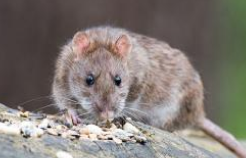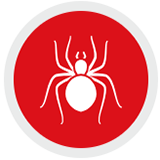Learning Center
Bed Bugs
Bed Bugs are small, flat parasitic insects that feed on the blood of human hosts. Although bed bugs had largely disappeared during the mid 20th century, a resurgence has taken place over the past decade.
Once thought to be a thing of the past, bed bugs have made a resurgence, infecting even the nicest homes, apartments, dormitories, and hotels. These pests are carried from one place to another on clothing, luggage, furniture, and boxes, and will set up residence in a new location quickly. They have also been found in movie theaters, stores, and other public venues.
The exact cause of their increased presence is not known. However, researchers at institutions such as the University of Kentucky and the University of California have recognized that new bed bug populations are highly resistant to common pesticides. According to the Centers for Disease Control, this phenomenon paired with our upwardly mobile society and decreased local/state pest prevention programs are all contributing factors.
Bed bugs feed primarily on human blood and are capable of living for long periods of time without eating. Once an infestation occurs, it can be extremely difficult to rid a home of bed bugs. These parasites can also be mistaken for wood ticks, spider beetles, woodlice, or carpet beetles, making them hard identify and treat appropriately.
Bed bugs have been in existence for 3,500 years. Their ability to hide and resistance to insecticides has made them a long-standing problem, especially for homeowners and residential facilities. In 2010, New York City experienced a major bed bug infestation, along with many other highly-populated cities.
What do bed bugs look like?
A bed bug’s body consists of a head, thorax, abdomen, and six legs. They also have wings (though they don’t fly), short hairs, a beak, and antennae. Adult bed bugs can grow to be 1/4” in length, which is about the size of an apple seed. Their bodies are brown, flat, and oval-shaped if they haven’t eaten, and reddish-brown, inflated and elongated after feeding. When unfed, an adult bed bug’s body is the width of a credit card.
How fast do bed bugs reproduce?
Bed bugs develop from egg to adult in six stages. Females can lay 3-5 pinhead-size, pearl-white-colored eggs per day. When the eggs hatch 6-10 days later, the young bed bugs are called nymphs and appear to be translucent or yellowish-white. To reach adulthood, the bugs must have a blood meal and will progress through 5 nymph stages over a period of about 6 weeks, molting between each stage. Adults feed every 5-10 days though they can survive up to a year, depending on temperature and humidity, without being fed.
What are the unique characteristics of a bed bug?
Bed bugs feed predominantly on human blood, typically biting during the night when they become most active. A bed bug will travel as many as 20 feet to reach a host and a single feeding can take up to 12 minutes. Bed bugs secrete an odor through their glands that is identified as both musty and sweet. In addition to pale-yellow molted exoskeletons, bed bugs may also leave reddish or rust-looking spots in their hiding places. These are remnants of previous meals and crushed bugs.
What are the habits of bed bugs?
Bed bugs are nocturnal, though they will come out during the day when desperate for food or in the event of an extreme infestation. Bed bugs usually nest in areas where people live, but they can piggyback on items like backpacks and purses, using non-residential settings such as schools and offices as transfer points from home to home.
Bed bugs do not like extreme heat or cold. Common bed bugs will die when their body temperature is higher than 113°F or lower than 46°F; some tropical species can survive in higher temperatures. Bed bugs can be found anywhere they have access to a host, typically human, upon which to feed.
Where are bed bugs are commonly found?
Because they are the width of a credit card, bed bugs can hide in even the smallest spaces. As their name implies, they will take up residence in the seams or piping of a mattress or box spring to be close to their host. Bed bugs can also be found in:
- Bed frames, headboards, and footboards
- Bedding
- Furniture
- Electrical outlets
- Carpet
- Clothes
- Luggage
- Corners of ceilings and walls
- Wall hangings
- Cracks and crevices
Bed bugs will travel through walls between apartments, dorm rooms, and hotel rooms in search of a host. They also spread by catching a ride on bags or other mobile items.
Will DIY treatments work?
Although DIY bed bug treatments will reduce the bed bug population, not all bed bugs can be killed in a single spray treatment because of the areas where bed bugs like to hide. Additionally, most bed bug pesticides will not kill the egg. This leads to several problems. First, new bed bugs will continue to hatch and more eggs will continue to be laid. This creates a never-ending cycle of bed bug treatments, needing to be perfectly timed to eventually rid your room of all bed bugs. The second issue is that after chemical treatments, the remaining bed bugs will begin to move from the treated rooms to safer rooms within your home, ultimately creating infestations in multiple rooms throughout your home. So while some DIY treatments, when executed perfectly, have the ability to work over time, they end up taking up a lot of time and resources, and carry with them a strong chance of worsening the infestation.
What are the risks of a bed bug infestation?
Bed bugs feed on blood obtained through biting their host. The bug uses its beak to inject an anesthetic that keeps the victim from feeling the bite and an anticoagulant that encourages blood flow. A single bug may bite multiple times. Bed bugs usually attack during sleep, feasting on skin that is exposed such as arms, legs, face, neck, hands, and shoulders.
Bed bugs do not transmit disease, but their bites can result in red welts, rashes, and hives. They may cause allergic reactions and, in extreme cases, anaphylactic shock. The visible presence of bed bugs can also create mental distress and fear of sleep in those whose home has been invaded.

 (425) 318-7912
(425) 318-7912
 MY ACCOUNT
MY ACCOUNT
 425-318-7912
425-318-7912







